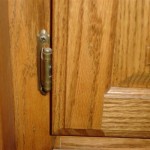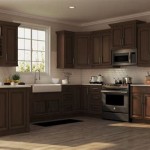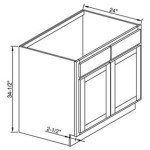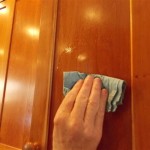Kitchen Cabinet Drawer Keeps Opening And Closing: Troubleshooting and Solutions
A kitchen cabinet drawer that repeatedly opens and closes on its own can be a significant source of frustration and inconvenience. This issue, while seemingly minor, can stem from a variety of underlying causes, ranging from simple alignment problems to more complex structural defects. Identifying the root cause is crucial for implementing effective and lasting solutions.
This article will explore the common reasons behind this problem, providing a systematic approach to diagnosing the issue and offering practical remedies to restore functionality and order to the kitchen. Understanding the mechanics of drawer operation and the potential points of failure will empower individuals to troubleshoot and resolve the problem effectively.
Understanding the Mechanics of Drawer Operation
Kitchen cabinet drawers typically rely on a system of drawer slides or glides to facilitate smooth movement. These slides are generally comprised of two components: one attached to the drawer box and the other mounted to the cabinet frame. These components interlock, allowing the drawer to extend and retract along a predetermined path. Proper alignment and smooth operation of these slides are essential for preventing unintentional opening and closing. Several factors can disrupt this delicate balance, leading to the problematic behavior in question.
The most common types of drawer slides include: roller slides, ball-bearing slides, and epoxy-coated slides. Roller slides are the simplest and most economical, using rollers to facilitate movement. Ball-bearing slides offer smoother operation and higher weight capacity, utilizing ball bearings within the mechanism. Epoxy-coated slides provide a balance between cost and performance and are often found in residential kitchens.
Irrespective of the type of slide, proper installation and maintenance are crucial for optimal performance. Misalignment, loose screws, and accumulated debris can all contribute to the drawer opening and closing problem. Therefore, a thorough inspection of the drawer slides is a necessary first step in the troubleshooting process.
Common Causes and Diagnostic Steps
Pinpointing the exact cause of a self-opening and closing drawer requires a methodical approach. The following are some of the most common culprits and the steps to diagnose them effectively:
1. Uneven Floor or Cabinet Installation: This is perhaps the most frequent cause. If the cabinet itself is not perfectly level, gravity will act on the drawer, causing it to slowly slide open or slam shut. The degree of the slope, even if seemingly insignificant, can be enough to initiate movement.
Diagnosis: Use a level, both horizontally and vertically, to check the cabinet frame and the floor beneath it. Place the level on the top surface of the cabinet and along the sides to identify any inconsistencies. If the floor is uneven, it will need to be addressed before attempting to fix the drawer. Similarly, if the cabinet is not level, it needs to be leveled using shims.
2. Misaligned Drawer Slides: Even if the cabinet is level, the drawer slides themselves might be misaligned. This can occur due to loose screws, warping of the cabinet frame, or improper initial installation. Misalignment can cause friction, uneven weight distribution, and ultimately, unwanted movement.
Diagnosis: Visually inspect the drawer slides on both sides of the drawer. Check if they are parallel to each other and properly aligned with the cabinet frame. Look for any gaps, bends, or signs of damage. Try gently pushing the drawer in and out to feel for any resistance or binding. A flashlight can be helpful to illuminate the inside of the cabinet and identify any hidden issues.
3. Loose Screws or Hardware: The screws that secure the drawer slides to the drawer box and cabinet frame can loosen over time due to vibration and repeated use. Loose screws can cause the slides to shift, leading to misalignment and instability.
Diagnosis: Carefully inspect all the screws that attach the drawer slides. Use a screwdriver to tighten any loose screws. If the screw holes are stripped, consider using longer screws or filling the holes with wood glue and toothpicks before re-inserting the screws.
4. Obstructions or Debris: Even small obstructions, such as crumbs, dust, or small objects, can interfere with the smooth operation of the drawer slides. These obstructions can create friction and prevent the drawer from closing completely, leading to it opening on its own.
Diagnosis: Remove the drawer completely and thoroughly inspect the drawer slides and the surrounding areas. Use a vacuum cleaner or brush to remove any debris. Pay particular attention to the tracks and rollers of the slides.
5. Worn or Damaged Drawer Slides: Over time, drawer slides can wear out due to friction and repeated use. This is especially true for inexpensive roller slides. Worn slides can develop excessive play, causing the drawer to wobble and open or close unintentionally. Physical damage, such as bent slides or broken rollers, can also contribute to the problem.
Diagnosis: Examine the drawer slides for signs of wear and tear, such as worn rollers, bent tracks, or excessive play. Try moving the drawer slides manually to feel for any roughness or resistance. If the slides are significantly worn or damaged, they will likely need to be replaced.
6. Overloaded Drawer: Exceeding the weight capacity of the drawer slides can put excessive strain on the mechanism, leading to premature wear and misalignment. A drawer that is consistently overloaded is more likely to exhibit the self-opening and closing behavior.
Diagnosis: Assess the contents of the drawer and determine if it is excessively heavy. Consider redistributing the contents to reduce the load on the drawer slides. Check the manufacturer's specifications for the weight capacity of the drawer slides to ensure that it is not being exceeded.
Practical Solutions and Remedial Actions
Once the underlying cause has been identified, the appropriate solution can be implemented. The following are some practical remedies for the common causes outlined above:
1. Leveling the Cabinet: If the cabinet is not level, use shims to adjust its height. Place the shims under the cabinet's feet or base until it is perfectly level in all directions. Secure the shims in place with adhesive or by screwing them into the floor if necessary. Re-check the drawer's operation after leveling the cabinet to ensure that the problem has been resolved.
2. Aligning Drawer Slides: If the drawer slides are misaligned, carefully adjust their position until they are parallel to each other and properly aligned with the cabinet frame. Loosen the screws that secure the slides, make the necessary adjustments, and then re-tighten the screws securely. Use a level to ensure that the slides are perfectly horizontal. If the screw holes are stripped, use longer screws or fill the holes with wood glue and toothpicks before re-inserting the screws.
3. Replacing Loose Screws: Tighten any loose screws that secure the drawer slides. If the screw holes are stripped, consider using longer screws or filling the holes with wood glue and toothpicks before re-inserting the screws. Apply a small amount of thread locker to the screws to prevent them from loosening again in the future.
4. Cleaning and Lubricating Drawer Slides: Remove any obstructions or debris from the drawer slides using a vacuum cleaner or brush. Lubricate the slides with a silicone-based lubricant to reduce friction and ensure smooth operation. Avoid using oil-based lubricants, as they can attract dust and debris. Apply the lubricant sparingly and wipe away any excess.
5. Replacing Worn or Damaged Drawer Slides: If the drawer slides are significantly worn or damaged, they will need to be replaced. Purchase new drawer slides that are compatible with the existing cabinet and drawer box. Follow the manufacturer's instructions for installation. When selecting new drawer slides, consider upgrading to ball-bearing slides for smoother operation and higher weight capacity.
6. Redistributing Weight: If the drawer is overloaded, redistribute the contents to reduce the load on the drawer slides. Consider storing heavier items in lower drawers or in other cabinets. Avoid placing excessively heavy items in drawers that are frequently used.
7. Installing Drawer Catches or Latches: In some cases, even after addressing the underlying causes, the drawer may still have a tendency to open slightly. In such situations, consider installing drawer catches or latches to keep the drawer securely closed. Magnetic catches and roller catches are common options. Install the catch on the cabinet frame and the corresponding strike plate on the drawer box. Adjust the position of the catch and strike plate until the drawer closes securely.
Addressing a kitchen cabinet drawer that repeatedly opens and closes involves a careful assessment of the drawer's mechanics, a systematic diagnosis of potential causes, and the implementation of appropriate solutions. By understanding the principles of drawer operation and following the outlined troubleshooting steps, this persistent kitchen issue can be efficiently and effectively resolved. Properly maintained and well-functioning cabinet drawers contribute to a more organized and user-friendly kitchen environment.

How To Keep Drawers Or Cabinets Sliding Open By Itself Easy Method

How To Stop A Drawer With Magnets

How To Fix A Broken Drawer The Home Depot

How To Remove Soft Close Drawer Kitchen

Kitchen Cabinet Drawer Latches For Our Skoolie

How To Fix A Sliding Out Drawer Bunnings Work Community

During An Inspection I Pulled Open A Kitchen Cabinet Drawer And It Slid Right Out Completely Unsecured This Kind Of Issue Might Seem Small But Can Lead To Injuries Shows Signs Poor

How To Fix A Broken Drawer The Home Depot

How To Fix A Broken Drawer The Home Depot

Kitchen Cabinet Drawer Fix Diy That Dreaded Busted Gone
Related Posts








